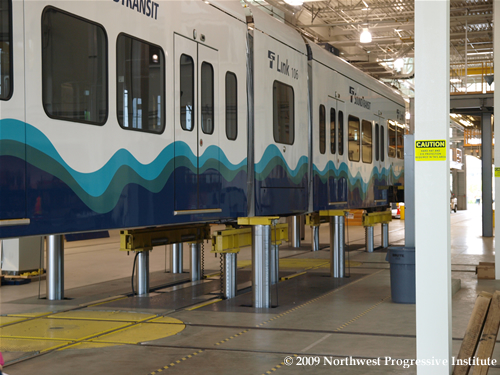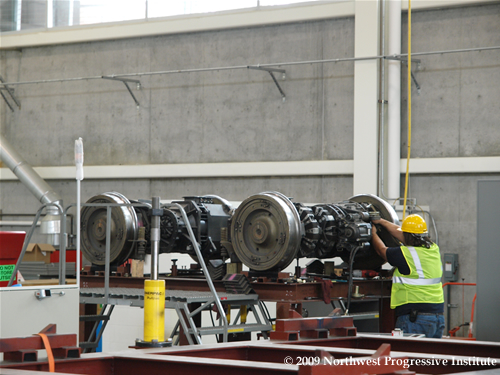Sound Transit's SoDo operations base offers state of the art train care
(Three, to be exact).
That and many other questions were answered for reporters this morning by Sound Transit's Paul Denison, who led a guided tour of the agency's Operations & Maintenance Facility in South Downtown for the press.
Loyal readers may recall that Sound Transit offered NPI a behind the scenes look at our region's new Central Link light rail system almost exactly a year ago, which I documented for The Advocate. Much of that tour took place inside the operations base, where Link cars are stored when they're not in service.
I went inside the base again last November to attend Sound Transit's post-election press conference following the passage of Proposition 1, so today's tour felt sort of like making a return trip to Disneyland (the kind of place that always feels fun to come back to.) While on the tour, I managed to get some very different shots that nicely complement the pictures I took last year.
Before I get to the pictures, let me elaborate a bit about the question I asked and then answered at the beginning of this post.
Link light rail trainsets do indeed have a total of not one, not two, but three braking systems for safety purposes.
First, there are the dynamic brakes, which effectively slow the trains down to between about ten to twelve miles an hour.
Dynamic brakes work by reversing the electrical current, causing the motor to exert torque in the direction opposite to which the train is traveling. Link's dynamic brakes happen to also be regenerative, which means they return electrical power to the overhead lines instead of releasing the energy as heat.
Second, there are the hydraulic disc brakes, which are also found in cars. Hydraulic disc brakes use friction to slow down the wheels. These brakes are used to bring Link trains to a complete stop.
Finally, there are the track brakes, which are only used in emergency situations. These brakes are deployed by releasing metal shoes onto the track, giving operators another way to slow a speeding train.
With that question answered, let's move on to the pictures.

This first shot shows the inside of the base's painting facility. This is where trains are painted and repainted when necessary.

This second shot shows the train wash. It looks kind of like a car wash, except it's for trains. According to Denison, trainsets are only washed when it's really necessary, and ideally not more often than once a week. The vehicles are designed to last for three decades. (Yes, you read that correctly.)

Here's a train that's resting on hydraulic lifts next to the truck shop. The lifts make it possible for workers to detach the wheels and brakes for service.

Finally, this photo shows Sound Transit personnel at work in the truck shop.
A few other interesting facts about Link trains: Each vehicle weighs about one hundred and six thousand pounds, and can carry two hundred people comfortably. Trains have floor heating as well as air conditioning from above, to keep passengers warm or cool depending on the season.
Closed circuit cameras are installed in the ceilings in every vehicle, recording footage to onboard digital video recorders. And the doors are all ADA accessible - no ramps are necessary to board because the trains have low floor designs.
Here's one last tidbit of interest: Unlike buses, trucks, or other rubber tire vehicles, Sound Transit's light rail trains are never operated in reverse. This is possible because the vehicles have cabs on both ends. To move a train in the other direction, the operator simply walks around to the other cab.
That's Link for you... always moving forward.


Comments:
Post a Comment